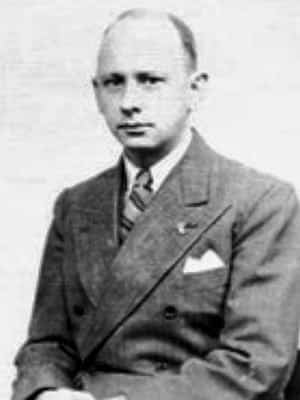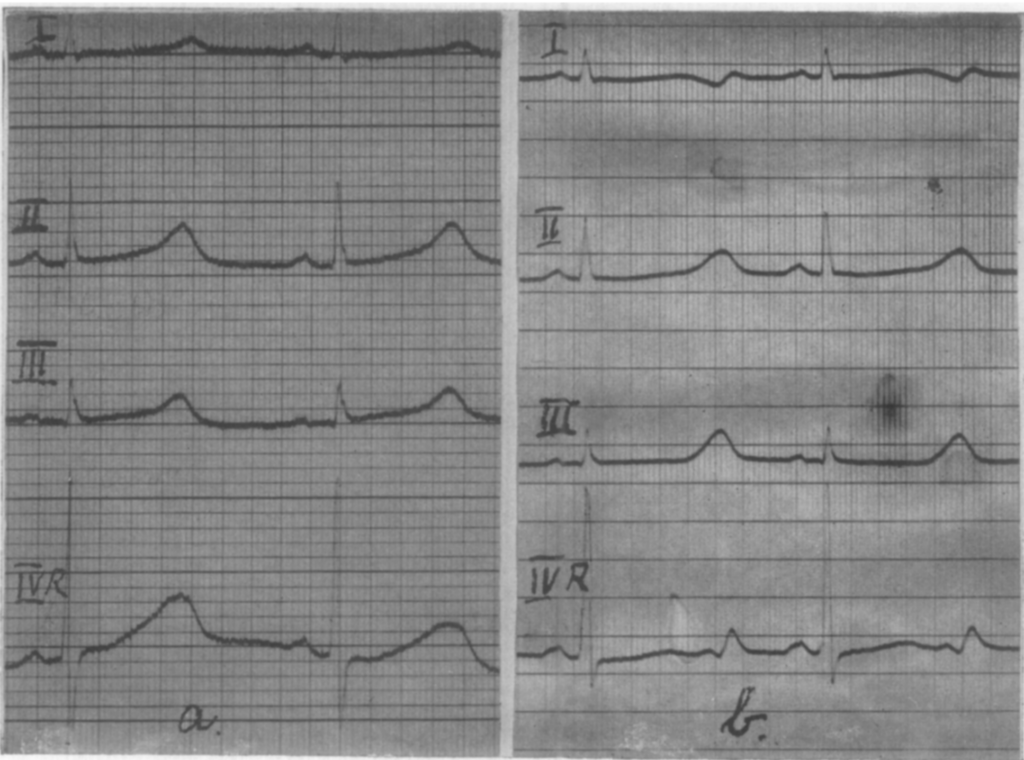Anton Jervell

Anton Jervell (1901-1987) was a Norwegian internist, cardiologist, and academic.
Best known as co-describer of Jervell and Lange-Nielsen syndrome, a rare inherited condition combining congenital deafness with long QT interval and sudden cardiac death. His work with Fred Lange-Nielsen in the 1950s marked one of the earliest recognitions of cardiac ion channelopathies, now understood as central to arrhythmogenic disorders.
Jervell trained in internal medicine and became one of Norway’s early experts in electrocardiography, completing a pioneering doctoral thesis on EKG changes in myocardial infarction in 1936. He rose to lead medical departments at Vestfold and later Ullevål sykehus in Oslo, where he was appointed professor of internal medicine. A skilled clinician and educator, Jervell also contributed to nursing education and held editorial roles with the American Heart Journal.
Despite his reserved manner, Jervell’s scientific legacy is enduring. His 1957 paper has been cited extensively in cardiology literature and remains the basis for understanding recessive long QT syndromes. He continued to publish on the subject into the 1980s, proposing alternate terminology such as “surdokardialt syndrom” (deaf-heart syndrome), though the eponym Jervell and Lange-Nielsen syndrome ultimately prevailed.
Biography
- Born on June 14, 1901 Kristiania (now Oslo), Norway. Son of a city treasurer.
- 1925 – Graduated in medicine.
- 1931–1935 – Worked on doctoral thesis at Ullevål sykehus, focusing on EKG findings in myocardial infarction. Approved as specialist in internal medicine (1933)
- 1936 – Earned doctorate (Dr. Med.) with a thesis on electrocardiographic findings in myocardial infarction.
- 1938 – Appointed chief physician at newly established medical department, Vestfold fylkessykehus in Tønsberg.
- 1942 – Senior Consultant of Medicine, Vestfold Hospital
- 1943 – Arrested by German forces during WWII in September; imprisoned for over two months.
- 1947 – Director of the Vestfold Hospital
- 1947-1967 Chairman of Tønsberg’s circle of the Red Cross, passionate humanitarian
- 1953 – Joined editorial board of American Heart Journal.
- 1955 – Applied for professorship at Ullevål sykehus; appointed overlege and professor of internal medicine, commencing January 1957.
- 1956 – Co-authored description of hereditary syndrome involving congenital deafness and prolonged QT interval with Fred Lange-Nielsen.
- 1957 – Their paper was published in American Heart Journal; condition later became known as Jervell and Lange-Nielsen syndrome. Proposed alternate name “surdokardialt syndrom” in Nordisk Medicin (1967)
- 1957–1972 – Served as overlege and professor at 8th department, Ullevål sykehus. Professor of Internal Medicine Ullevål Hospital & University of Oslo
- 1966 – Published three additional cases of the syndrome.
- 1967 – Knight of the Royal Norwegian Order of St. Olav
- 1971 – Summarised 27 global cases of the syndrome in a review article.
- 1985 – Published final article on the syndrome, reflecting on 30 years of experience.
- 1987 – Died December 29, 1987 in Norway.
Medical Eponyms
Jervell and Lange-Nielsen syndrome (JLNS) (1957)
Congenital (autosomal recessive) long QT syndrome (LQTS) associated with severe, bilateral sensorineural hearing loss.Two genetic mutations identified encoding cardiac potassium channels. Due to high risk of sudden cardiac death ICD implantation is usually required
1957 – NJervell (1901-1987) with his colleague and jazz virtuoso Fred Lange-Nielsen (1919-1989) described an autosomal recessive syndrome of long-QT interval with deafness and sudden death
Four cases of deaf-mutism combined with a peculiar heart disease have been observed in one family. The parents and 2 other children were healthy and had normal hearing. The deaf-mute children all suffered attacks of fainting, probably Adams-Stokes seizures caused by standstill of the heart. The first attack occurred between the ages of 3 and 5 years, and 3 of the children died in such attacks at the ages of 4, 5, and 9 years, respectively.
Electrocardiographic studies in 3 of the cases revealed a marked prolongation of the Q-T interval.
Am Heart J. 1957
Jervell and Lange-Nielson recounted one case of a young boy, born in 1944 suffering from repeated ‘fainting attacks’ since the age of 3. The attacks usually occurred following effort. Occasionally the boy had complained of palpitations and precordial pains. In July, 1953, he was examined with the only pathologic finding being a prolongation of the Q-T interval in the electrocardiogram, worse following exercise. On Nov. 19, 1953, he had a further attack. He suddenly became pale and fell unconscious and died.

(a) ECG July 20. 1953, during rest. Leads I, II, III. IVR. Q-T = 0.50s. R-R = 0.88s.
(b) ECG July 20, 1953. after stair-running. Leads I. II. III, IVR. Q-T = 0.60s R-R = 0.86s. Jervell A, Lange-Nielsen F. 1957
Key Medical Contributions
Education and Clinical Leadership
Jervell was an early expert in electrocardiography and myocardial infarction. His doctoral thesis in 1936 was one of Norway’s first works on EKG, at a time when the technology was new and cardiac infarction poorly understood. As chief physician in Tønsberg and later professor at Ullevål sykehus, he played a formative role in shaping Norwegian internal medicine and postgraduate training. He also edited a major nursing textbook used for three decades.
Legacy and Recognition
Although modest in style, Jervell’s scientific rigor earned wide respect. He continued to publish on the syndrome into the 1980s. The eponym “Jervell and Lange-Nielsen syndrome” became entrenched internationally, and his 1957 paper has been cited over 1,400 times. He advocated calling it “surdokardialt syndrom” (deaf-heart syndrome), but the eponym endured. A portrait of Jervell hangs at Ullevål sykehus in honour of his contributions.
Major Publications
- Jervell A, Lange-Nielsen F. Congenital deaf-mutism, functional heart disease with prolongation of the Q-T interval and sudden death. Am Heart J. 1957 Jul;54(1):59-68
- Jervell A. Pulseless disease. Am Heart J. 1954 May;47(5):780-4
- Jervell A. [Extrasystole]. Tidsskr Nor Laegeforen. 1963 Feb 1;83:257-62
- Jervell A. The surdo-cardiac syndrome. Eur Heart J. 1985 Nov;6 Suppl D:97-102
References
Biography
- Steenstrup B. Jervell, Anton’. Hvem er hvem?. Oslo: Aschehoug 1973: 283–284.
- Beighton G, Wiedemann HR. Anton Jervell In: The Person Behind the Syndrome. Springer. 1997: 96-97
- Eriksen TL. The origins of a special relationship: Norway and Southern Africa 1960–1975. I: Eriksen TL, red. Norway and National Liberation in Southern Africa. Uppsala: Nordiska Afrikainstitutet, 2000: 33-34
Eponymous terms
- Levine SA, Woodworth CR. Congenital deaf-mutism, prolonged QT interval, syncopal attacks and sudden death. N Engl J Med. 1958 Aug 28;259(9):412-7.
- Eponymythology. History of the Electrocardiogram. LITFL
Eponym
the person behind the name
BA MA (Oxon) MBChB (Edin) FACEM FFSEM. Emergency physician, Sir Charles Gairdner Hospital. Passion for rugby; medical history; medical education; and asynchronous learning #FOAMed evangelist. Co-founder and CTO of Life in the Fast lane | On Call: Principles and Protocol 4e| Eponyms | Books |
